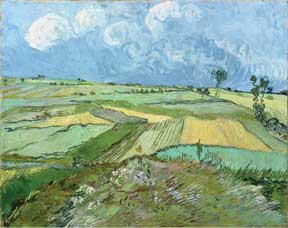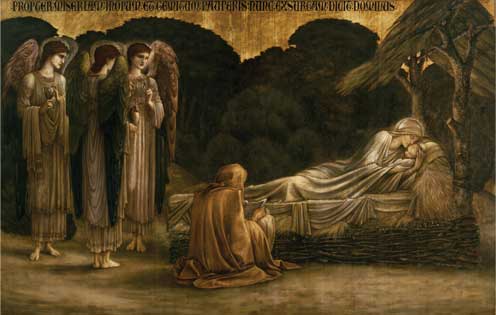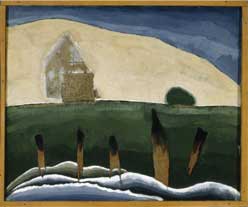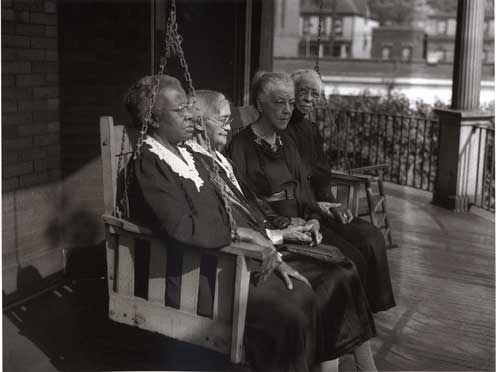Summer 2010
 |
||||||||||||||||||
Alberto Giacometti’s Walking Man I (center) has been a museum highlight since 1961.Photo: Tom Little© 2010 Succession Giacometti / Artists Rights Society (ARS), New York / ADAGP, Paris© 2010 Kate Rothko Prizel & Christopher Rothko / Artists Rights Society (ARS), New York |
Ode to a Collection
Carnegie Museum of Art’s far-reaching and ever-growing collections are a 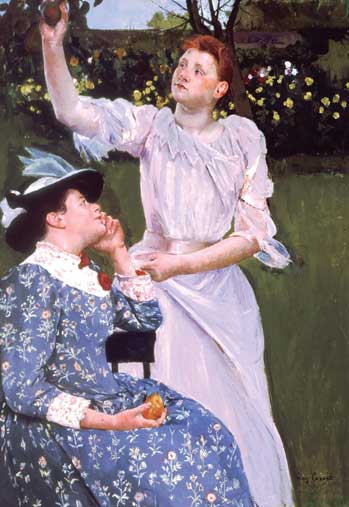 World-class, brooding, iconic, modern, and, in the words of noted author and Pittsburgh native Annie Dillard, “in spirit and in form a dissected nerve”—the work on display in gallery 13 of the museum’s Scaife Galleries embodies the strengths of a collection that continues to inspire first-time visitors, longtime fans, and international art enthusiasts. (It’s worth noting that Walking Man I isn’t the only Giacometti the museum owns; currently not on view is a smaller 1950 sculpture, Four Figures on a Pedestal, and two oil-on-canvas paintings.) World-class, brooding, iconic, modern, and, in the words of noted author and Pittsburgh native Annie Dillard, “in spirit and in form a dissected nerve”—the work on display in gallery 13 of the museum’s Scaife Galleries embodies the strengths of a collection that continues to inspire first-time visitors, longtime fans, and international art enthusiasts. (It’s worth noting that Walking Man I isn’t the only Giacometti the museum owns; currently not on view is a smaller 1950 sculpture, Four Figures on a Pedestal, and two oil-on-canvas paintings.) Mary Cassatt, Young Women Picking Fruit, 1891, Patrons Art FundStrengths in half a dozen areas—American art from the mid-19th century to the present; French Impressionist and Post-Impressionist paintings; significant late 20th- and early 21st-century works; European and American decorative arts from the late 17th century to the present; and architectural drawings and models—define the museum’s diverse and distinguished collection. Also of note are holdings in photography, film and video, and Japanese prints. Of its highlights, the most widely recognized may be the museum’s Impressionist paintings, permanently on view in the Scaife Galleries. “A few key works were bought early—an [Alfred] Sisley and a [Camille] Pissarro in the 1890s, and the Cassatt in the 1920s,” says Louise Lippincott, the museum’s curator of fine arts. Mary Cassatt, creator of Young Women Picking Fruit, was the only American of her day invited to exhibit with the French Impressionists. The native Pittsburgher also participated in 18 Carnegie Internationals between 1899 and 1926. “The second acquisition campaign came in the late 1960s and early ’70s,” Lippincott notes. “Most of the famous ones came then: Monet’s Water Lilies, Van Gogh’s Wheat Fields, and the like. Almost all were acquired with funds from Sarah Mellon Scaife, who also gave us the Scaife building.” Starting With The ClassicsLongtime docents like Marilyn Finberg, who lead daily tours of the museum’s collection and changing exhibitions, say most first-time visitors arrive armed with a list of must-see works. “Any of the well-known Impressionist paintings,” she says, “and the Jackson Pollock and [Willem] de Kooning. The names that people know.” But Finberg adds that newcomers quickly discover the depth of the museum’s collection.“They’re pleasantly surprised, especially by the 20th-century art. And most don’t know about the Hall of Architecture,” she notes, which is home to life-sized plaster re-creations of some of the world’s great historic architecture, including the largest architectural cast ever made: the west portal of the Benedictine abbey of St.-Gilles-du-Gard. The hall’s impressive collection of architectural and sculptural casts is one of the three largest in the world. 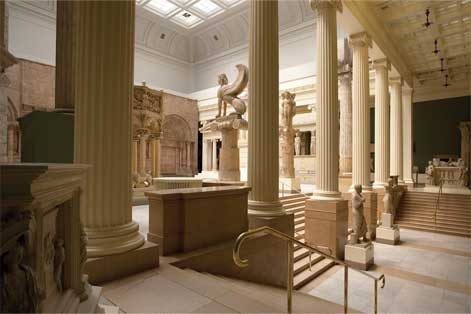 The Hall of Architecture boasts the third largest collection of architectural casts in the world.Finberg often begins her tours on the museum’s ground floor in the Halls of Sculpture and Architecture, where what she calls “the classics” lay the foundation for the art that lies ahead. “It’s the Grand Tour, as it were,” notes Finberg. “We walk from ancient Greece to Rome to medieval France, and people are totally blown away by the spaces.” Diane Samuels, a local artist with an international reach who has exhibited work as part of the museum’s ongoing Forum series, often follows suit, beginning many of her visits in the Hall of Sculpture. Gesturing far above the classical sculptures, she points to The Tongue of the Cherokee, an installation in which German conceptual artist Lothar Baumgarten inscribed the characters of the first written Native American language on the room’s glass skylights. She notes that the site-specific work, created for the 1988 Carnegie International, brings an authentic American note to a hall that was modeled on the Parthenon, the ancient temple of Athena in Greece. In her own work in a wide range of media, Samuels often inscribes text on surfaces, and she connects to Baumgarten’s runic pattern. “The fact that there are some characters that you recognize draws you to it. And it’s so perfectly integrated into the room. Instead of seeing it at eye level, you have to lift your head. And I like the blue [letters]—it’s an alphabet that reads like the sky.” Celebrating Genius Among UsFor Samuels, a Long Island native and Carnegie Mellon University graduate who spent countless student hours sketching within its walls, the Hall of Architecture is another beloved friend. “It’s all eyeball scale,” she says. “I love the chewed edges of the pillars, and the little faces” in the ornately carved baptistery doors. She likens the casts to the prehistoric fish fossils in the Museum of Natural History, another favorite on her frequent visits: “You can stare at them for a long time,” she says.Samuels fondly recalls Leon Arkus, director of Carnegie Museum of Art from 1968 to 1980, who mentored her as a student and often strolled the galleries with her. “He’d circle a room and, suddenly, he’d be pulled to one work like a magnet.” It was Arkus who introduced Samuels to paintings in the collection by American artists such as Pittsburgher John Kane (the subject of an Arkus book) and Arthur G. Dove. Dove’s works, specifically Huntington Harbor II on view in gallery 11, interest Samuels. “They’re just teeny pictures with simple shapes,” she notes, “made from sand and wood chips. The crudeness is pretty fabulous.” Kane, now a widely collected modernist master, was an untrained Pittsburgh carpenter when his first work was accepted to the Carnegie International in 1927. “Genius has been discovered!” reported the Pittsburgh Press at the news of the jury’s decision. The museum’s collection of paintings by Kane, the largest in the world, underscores the importance of Carnegie Internationals in building the permanent collection. More than 300 works have entered the museum’s holdings by way of the International over the past century. The very first International, in 1896, set the standard for world-class collecting at Carnegie Museum of Art. Pieces shown and purchased by Andrew Carnegie that year included a pair of famous American paintings: Winslow Homer’s The Wreck and James Abbott McNeill Whistler’s Arrangement in Black: Portrait of Señor Pablo de Sarasate, the first work by the artist bought by an American museum. It was just as cutting-edge in its day as the museum’s most recent acquisition, Haegue Yang’s Series of Vulnerable Arrangements–Domestics of Community, a room-sized installation by the Korean artist who exhibited in Life on Mars, the 2008 Carnegie International. The UnexpectedCarnegie’s ambition to collect the “old masters of tomorrow” put modernism in the museum’s DNA, and the contemporary collections have long been the beneficiary of new works acquired after Carnegie Internationals. But other acquisitions have joined the collections in some surprising ways, and Marilyn Finberg enjoys sharing some of the more interesting stories with visitors.Pausing by The Nativity, an 1888 canvas by Edward Burne-Jones, Finberg points out the unusual expressions of its subjects: Instead of seeming joyful, they are beautifully restrained and sad. As she describes the solemn, even somber, scene, she adds that the acquisition of the work was actually the happy result of a visit to the museum by composer Andrew Lloyd Webber, a well-known collector of pre-Raphaelite art. After viewing the museum’s holdings by Burne-Jones and other members of the Victorian group of artists, he offered in 1997 to sell his painting to the museum. The following year, the museum unveiled another glittering jewel of its collection: the gilded panels of The Chariot of Aurora, a stunning Art Deco wall relief designed for the Grand Salon of the Normandie, the most glamorous ocean liner of the 1930s. Donated to the Museum of Art in 1993 by Frederick Koch and unveiled after painstaking conservation in 1998, the magnificent work “put the museum’s Art Deco collection firmly on the map,” said Louise Lippincott at the time. Finberg adds a postscript to the grand Normandie saga: the story of the gilded and red lacquer doors that followed the panels to the museum. After the Normandie was taken out of commission in 1941, all the lacquer decorations from the Grand Salon were removed to storage. In 1949, The Chariot of Aurora was re-hung on another French liner, the Ile de France, which required replacing the two gilded and red lacquer doors with eight additional relief panels. Eventually, the doors migrated to Mr. Chow’s, a landmark Chinese restaurant in Manhattan. Upon hearing of Koch’s gift to Carnegie Museum of Art, Mr. Chow himself donated the set to the museum, where they complete the famous installation.
“The quieter works deserve attention.”
- Louise Lippincott, curator of fine artsThe Experts’ PicksThe Scaife Galleries’ lesser-known works are as familiar as its marquee pieces to Lippincott, and no less important. The curator’s expertise in 18th- and 19th-century European art, displayed in blockbuster exhibitions such as Fierce Friends: Artists & Animals, 1750–1900 and Light! The Industrial Age, 1750–1900, gives her a special appreciation for subtle period works that flank the famed Monets, Pissarros, and Van Goghs.“The quieter works deserve attention,” she says. “[François Joseph] Bosio’s Henri IV as a Child is rare. It’s very unusual,” she notes. “It’s a statue of a nine-year-old boy, on an original pedestal, that was made by a woman artist (Félicie de Fauveau).” She likens another sculpture, the 1874 Dorothy Heseltine, to “what Renoir did with paint.” Lippincott notes that the French terracotta bust by Aimé-Jules Dalou complements the collection’s strong Impressionist paintings. She also admires the simplicity of Glass of Water and Coffee Pot, a 1761 composition by Jean-Siméon Chardin—“really superb,” she comments. Lynn Zelevansky, The Henry J. Heinz II Director of Carnegie Museum of Art, looks at the same piece through the lens of a contemporary curator, yet she agrees wholeheartedly. “There’s something so modern in its simplicity,” she marvels. Another piece that draws in both experts is John Singer Sargent’s Venetian Interior of c. 1880–1882, a somber rendition of a darkened room. “I love the floating rectangles,” says Zelevansky. “It’s very abstract.” Soon after arriving at Carnegie Museum of Art, Zelevansky took on the daunting task of choosing standouts from the museum’s collections when she agreed to select 37 pieces for a book entitled Director’s Choice. Part of a series from Scala Publishers that features the collections of the world’s top museums, Zelevansky’s contribution, to be published in November, forced her to cull from the museum’s masterworks. “I would have preferred to do it a year later,” she says with a laugh. Both Whistler’s Arrangement in Black and Sargent’s Venetian Interior made her list, along with photography by Charles “Teenie” Harris, Eugene Smith, and Duane Michals. Zelevansky’s inclusion of three photographers who took Pittsburgh as a subject is a definite nod to the museum’s strength in that medium. Popular with local visitors, the photographic works also inspire other artists. The Famous and Not-So-Famous
 Haegue Yang, Series of Vulnerable
| |||||||||||||||||
Also in this issue:
Growing Up With Science · The Disappeared · Twisted Pair · Special Supplement: A Tribute to Our Donors · Directors' Note · NewsWorthy · Face Time: Zhe-Xi Luo · Artistic License: Domestic Explorations · Science & Nature: Geological Wonder · About Town: Artists Among Us · The Big Picture
 |
Copyright © 2017 CARNEGIE Magazine. All rights reserved. |

